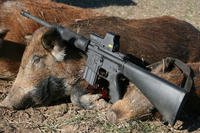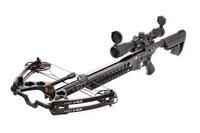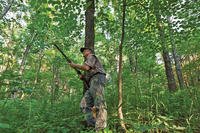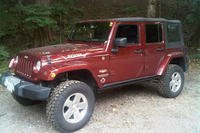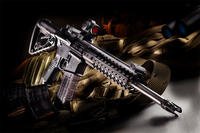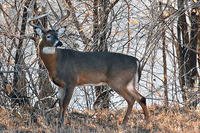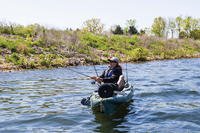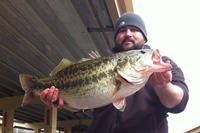Screeeee! The right front A-arm drags over a small granite boulder, sounding like a giant fingernail scraping a blackboard. Bam! The rear differential smacks a rocky ridge in the center of a two-track and then trails a thin web of gear oil. Thump! The front end falls onto a muddy ledge between deep ruts, followed by the spinning of tires.
Any outdoorsman who's made a trip over unimproved roads on the way to a favorite camping, hunting or fishing area knows the hazards that lie in wait on even a mild trail.
But there are a host of easy suspension fixes and new products on the market that can hoist the undercarriage of your truck or SUV a couple inches out of harm's way without turning it into an outsized, rough-riding, ill-handling monster riding on shoulder-high tires.
"Most sportsmen can benefit from increases in both ground clearance and better traction from taller, more aggressive tires," says Trent McGee, director of marketing for Daystar Products International, one of today's renowned aftermarket suspension manufacturers. "A suspension leveling kit or a moderate [2- to 6-inch] lift kit will pave the way for sportsmen to do both. With primitive roads, clearance and traction are the best ways to enhance the utility of a vehicle."
Lifted or Level
While both leveling kits and moderate lift kits raise the suspension to accommodate plus-size (larger-than-stock) tires, there are specific differences between the two. A leveling kit generally consists of a spacer or a replacement front spring that increases the ride height of the front suspension, allowing a taller tire to be fitted.
Most current pickups are built with a forward rake, where the rear sits higher than the front. When a load is placed in the bed, the rear settles on the springs and the stance evens out. But many owners don't like that stock "stink bug" look when the vehicle is unloaded, so they install a leveling kit to bring the front end up a couple inches to match the rear.
The ability to install larger tires — gaining that crucial inch or two or added ground clearance — is a tangible side benefit of adding a leveling kit.
For example, on the 2007-up Toyota Tundra, a 21⁄2-inch leveling kit allows the installation and use of 33x12.50 tires, which would otherwise rub in the front.
Most tire clearance issues arise in the front fenders long before the rear is an issue. That's because the front tires turn, and in doing so, the clearance at the rear of the fender well becomes a problem as the tire cycles left or right. In most cases, the rear suspension already includes enough room for a slightly taller tire.
There are further product distinctions on the leveling-kit side. For instance, the Rancho Suspension division of Tenneco produces the QuickLift for coil-spring independent front suspensions, and Cognito Motorsports builds a leveling kit for torsion-bar front ends.
"The QuickLift allows us to optimize the height of the spring seat as well as the length of the shock rod on the original-equipment package so that we can mount it taller," explains Bill Johnson, engineering manager for Rancho.
"We can gain from 1 to 21⁄2 inches of ride height by installing what essentially looks identical but in fact is a slightly modified product that doesn't destroy the stock geometry or cause the suspension to top out or bottom out. That product applies to all late-model 1⁄2-ton vehicles and most of the imports."
"True ground clearance is measured under the lowest point of the vehicle," explains Marc Bowers, technical supervisor for Seattle-based ARB USA and the distributors for the Australian Old Man Emu suspension brand. "That's typically under the center of the axle housings."
"The only way you can actually gain ground clearance is by putting a larger diameter tire on the vehicle. A tire 2 inches taller than the one it replaces adds an inch of ground clearance. That extra inch can be all the difference needed to avoid high-centering the chassis or dragging differential housings," says Bowers.
Longer wheelbase vehicles require more suspension lift to achieve the same off-road ability as a short-wheelbase vehicle.
For instance, if you lift a Jeep with a 90-inch wheelbase three inches, it makes a big difference how the center of the truck passes over obstacles. If you lift a 140-inch-wheelbase F-150 three inches, it doesn't make that significant a difference.
Real Lift Kits
That's where full suspension lifts come into play. Such kits come with a combination of front and rear suspension components (depending on lift size), which are replaced to both level and raise vehicle ride height.
Lifts may range from minimal 2-inch systems to 10 inches or more in extreme cases.
For the sportsman application, moderate lift kits up to four inches for short-wheelbase vehicles are the norm while six-inch lifts are optimal for long-wheelbase vehicles like full-size pickups and SUVs.
"Only vehicle owners and their pocketbooks can make the decision as to whether a leveling kit or a lift kit is more appropriate," says S. Kellie Colf, market development manager for Eaton Detroit Spring Inc. "However, one must keep a few things in mind when a lift is being considered.
"Most factory-equipped vehicles," he says, "allow for limited lifting without changing major components. A moderate lift for either a coil-spring suspension or a leaf-spring suspension can usually be done by simply changing springs."
"With anything beyond a couple of inches, though, items such as steering components, driveshaft lengthsand angles, crossmembers, as well as brake components and bracketry need to be changed to safely allow for the ride-height increase," says Colf.
IFS Suspension Concerns
Chad Troxler, a member of the Cognito Motorsports sales and marketing staff, said that his company's torsion bar and upper control arm leveling kit is designed for specific vehicles with independent front suspensions (IFS), such as the late-model GM pickups and SUVs.
Sportsmen on a tight budget used to "crank up" IFS front suspensions by adjusting a key at the rear of the torsion bar mount. That lifted the front of the truck as much as a couple inches.
The problem with that "free lift" is the truck's built-in front suspension down-travel was negated and it also extended the factory shocks close to their limit. The result is a hard "thump" every time the wheel dropped into a rut or went over a small bump.
"We solve those issues in our IFS leveling kits by changing out the upper A-arm as well as a new upper A-arm and lower shock extenders, or by providing longer shocks," explains Troxler.
"We change out the upper A-arm because it's the limiting factor that takes away ride quality. The new A-arm increases wheel travel and allows you to crank the key to level the truck but keep a good ride."
Riding on Air
Another lift option is air suspension, which utilizes air helper springs or "bags" to increase the carrying capacity of a suspension. As an air bag is inflated in place of, or augmenting a standard spring, it stiffens the suspension and adds ride height.
"One of the things that we try to address with air suspension is keeping a vehicle at a level condition all the time, whether loaded or unloaded," says Paul Gibson, product manager for Firestone's Ride-Rite division. "With an air suspension, sportsmen can inflate the system on the weekend to meet their needs for the load in the bed, to tow a travel trailer or boat, or to get the ride height they're looking for on a two-track into the woods," says Gibson.
Some air suspensions offer the added benefit of an on-board air compressor, which may be used to not only adjust bag pressures but also to inflate tires, water toys, rafts, float tubes, or other equipment.
Lifting Thoughts
But regardless of how taller tires are ultimately fitted, side issues such as fuel economy and overall vehicle handling can become significant factors as tire diameter — and, consequently, vehicle height — increase.
"A lot of the fuel economy, ride, and handling issues will depend on what kind of tire you put on with the suspension system," Mark Mathews, marketing manager for Pro Comp Suspension, says while looking out over one their R&D center's installation bays. "You're adding weight to each corner with taller, heavier tires and wheels, which will affect braking and turning."
"Fuel economy is dependent on many factors including driving style. But it will deteriorate with the larger wheels and tires because it takes more power to turn them. Aerodynamic drag also plays a significant role; it takes more power to go down the road because your vehicle's profile is taller and it catches more air."
If a pickup is fitted with a heavy slide-in camper, center of gravity becomes even more of an issue. For that type of application, either air springs, "helper" rear springs, or a combination of both might be needed in shouldering the load.
Shocks Matter
Additional unsprung weight — the mass that is supported by the springs, such as the oversize tires — may also overpower stock springs, causing them to oscillate excessively when the suspension compresses and rebounds over obstacles.
That's why using the best shock absorbers available are crucial to suspension performance.
Shocks are designed to dampen or control spring oscillations, allowing the suspension to flex over bumps, but then slowing or halting the oscillations as the suspension again encounters smoother terrain.
"Shock absorbers really need to be valved correctly for the vehicle," Bowers counseled. "We can set up a shock that has very soft ride characteristics if you're driving slowly along a rough, rocky trail or muddy, rutted forest road.
"But when you hit a big dip in the highway at 70 miles an hour, that shock needs to be firm to control the vehicle. We build those ride control attributes into our Old Man Emu shocks so they deliver a ride that's really good off-road yet provide excellent control on the highway without being jarring and aggressive."
Some companies also offer "adjustable" shocks, which can be tuned by the vehicle owner for varying loads and conditions. Rancho's RS9000, for instance, provides nine different settings.
"There is a knob on each shock," Johnson explains. "Position one is the softest setting; position nine is the firmest. You can virtually dial-in all four corners if you want to, but a sportsman would typically adjust the fronts to one setting and the rear shocks to another to get the best balanced ride."
Tow Ratings & Lift Kits
Sportsmen also need to be aware tow ratings decrease when a taller tire/wheel package is added along with the suspension lift.
While suspension changes may not affect gross vehicle weight or tow ratings alone, the automakers engineer their systems to accommodate a whole range of components, including wheel bearings, brakes, steering components and more, all of which come together in an elaborate formula to establish the ratings for maximum GVW and towing.
"The tendency with a lot of owners is to go with the largest rim and the shortest sidewall possible," Mathews says. "You can end up with 35-inch tires on 22-inch rims, and the load rating for those wheels and tires is a lot less than stock 30-inch tires mounted on 17- or 18-inch wheels.
"A plus-size tire-and-wheel combination will have a lot to do with your vehicle's tow and load ratings, so you should check with the vehicle manufacturer to be sure you're in the proper range. Some of these wheels and tires are not intended for heavy loads; they're designed more for looks on the street — not performance in the backwoods," warns Mathews.
As you can see, the broad range of suspension options can be mind-numbing. The best options depend upon the type of pickup or SUV you drive, the terrain to be encountered, the type of loads carried and, of course, price considerations.
Research before you buy, don't just look at the ads; take the time to make a few phone calls to the suspension suppliers and to drop by your local four-wheel-drive or suspension shop to hear what specific recommendations they offer.
Adding a lift or leveling kit to your favorite 4x4 and up-sizing the tires will make the difference keeping the underside out of harm's way.
Tire/Wheel Combos
Tire sidewall height should be very important to sportsmen. Although short sidewalls, say 35s mounted on 22-inch rims, might look sick, in reality they are a problem just waiting to strike. Any tires on a pickup or SUV used for hunting, fishing, exploring should be mounted on nothing taller than 18-inch rims.
That additional inch or two of tire sidewall gained by staying with 18s instead of 20s or 22s protects the rim — and the tire from rolling off the rim — when it suddenly impacts a hidden rock or other sharp object.
The taller sidewall also provides your vehicle with a little extra suspension from the sidewall's flex, making both on- and off-pavement ride more comfortable. The short sidewall tires and tall wheels you see on many boulevard cruisers have no place on an outdoorsman's truck.

